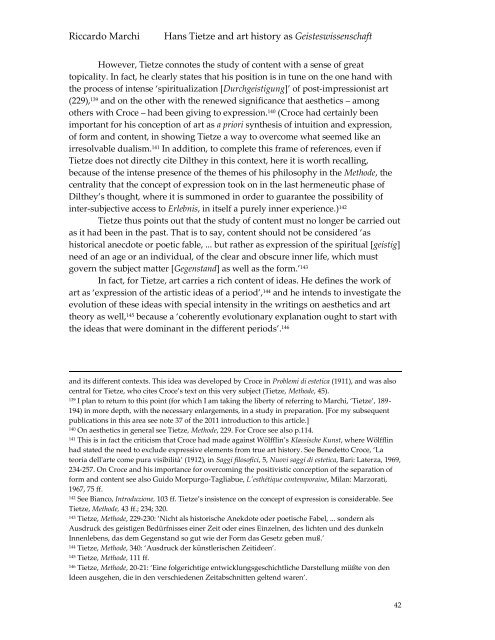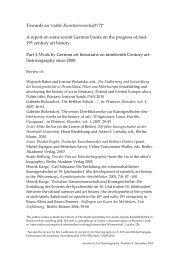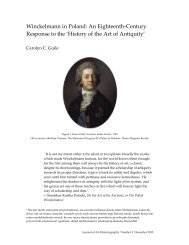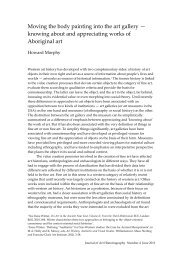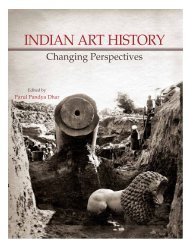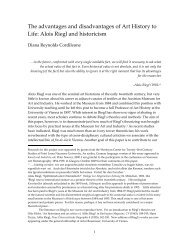Geisteswissenschaft - Journal of Art Historiography
Geisteswissenschaft - Journal of Art Historiography
Geisteswissenschaft - Journal of Art Historiography
You also want an ePaper? Increase the reach of your titles
YUMPU automatically turns print PDFs into web optimized ePapers that Google loves.
Riccardo Marchi Hans Tietze and art history as <strong>Geisteswissenschaft</strong><br />
However, Tietze connotes the study <strong>of</strong> content with a sense <strong>of</strong> great<br />
topicality. In fact, he clearly states that his position is in tune on the one hand with<br />
the process <strong>of</strong> intense ‘spiritualization [Durchgeistigung]’ <strong>of</strong> post-impressionist art<br />
(229), 139 and on the other with the renewed significance that aesthetics – among<br />
others with Croce – had been giving to expression. 140 (Croce had certainly been<br />
important for his conception <strong>of</strong> art as a priori synthesis <strong>of</strong> intuition and expression,<br />
<strong>of</strong> form and content, in showing Tietze a way to overcome what seemed like an<br />
irresolvable dualism. 141 In addition, to complete this frame <strong>of</strong> references, even if<br />
Tietze does not directly cite Dilthey in this context, here it is worth recalling,<br />
because <strong>of</strong> the intense presence <strong>of</strong> the themes <strong>of</strong> his philosophy in the Methode, the<br />
centrality that the concept <strong>of</strong> expression took on in the last hermeneutic phase <strong>of</strong><br />
Dilthey’s thought, where it is summoned in order to guarantee the possibility <strong>of</strong><br />
inter-subjective access to Erlebnis, in itself a purely inner experience.) 142<br />
Tietze thus points out that the study <strong>of</strong> content must no longer be carried out<br />
as it had been in the past. That is to say, content should not be considered ‘as<br />
historical anecdote or poetic fable, ... but rather as expression <strong>of</strong> the spiritual [geistig]<br />
need <strong>of</strong> an age or an individual, <strong>of</strong> the clear and obscure inner life, which must<br />
govern the subject matter [Gegenstand] as well as the form.’ 143<br />
In fact, for Tietze, art carries a rich content <strong>of</strong> ideas. He defines the work <strong>of</strong><br />
art as ‘expression <strong>of</strong> the artistic ideas <strong>of</strong> a period’, 144 and he intends to investigate the<br />
evolution <strong>of</strong> these ideas with special intensity in the writings on aesthetics and art<br />
theory as well, 145 because a ‘coherently evolutionary explanation ought to start with<br />
the ideas that were dominant in the different periods’. 146<br />
and its different contexts. This idea was developed by Croce in Problemi di estetica (1911), and was also<br />
central for Tietze, who cites Croce’s text on this very subject (Tietze, Methode, 45).<br />
139 I plan to return to this point (for which I am taking the liberty <strong>of</strong> referring to Marchi, ‘Tietze’, 189-<br />
194) in more depth, with the necessary enlargements, in a study in preparation. [For my subsequent<br />
publications in this area see note 37 <strong>of</strong> the 2011 introduction to this article.]<br />
140 On aesthetics in general see Tietze, Methode, 229. For Croce see also p.114.<br />
141 This is in fact the criticism that Croce had made against Wölfflin’s Klassische Kunst, where Wölfflin<br />
had stated the need to exclude expressive elements from true art history. See Benedetto Croce, ‘La<br />
teoria dell'arte come pura visibilità’ (1912), in Saggi filos<strong>of</strong>ici, 5, Nuovi saggi di estetica, Bari: Laterza, 1969,<br />
234-257. On Croce and his importance for overcoming the positivistic conception <strong>of</strong> the separation <strong>of</strong><br />
form and content see also Guido Morpurgo-Tagliabue, L'esthétique contemporaine, Milan: Marzorati,<br />
1967, 75 ff.<br />
142 See Bianco, Introduzione, 103 ff. Tietze’s insistence on the concept <strong>of</strong> expression is considerable. See<br />
Tietze, Methode, 43 ff.; 234; 320.<br />
143 Tietze, Methode, 229-230: ‘Nicht als historische Anekdote oder poetische Fabel, ... sondern als<br />
Ausdruck des geistigen Bedürfnisses einer Zeit oder eines Einzelnen, des lichten und des dunkeln<br />
Innenlebens, das dem Gegenstand so gut wie der Form das Gesetz geben muß.’<br />
144 Tietze, Methode, 340: ‘Ausdruck der künstlerischen Zeitideen’.<br />
145 Tietze, Methode, 111 ff.<br />
146 Tietze, Methode, 20-21: ‘Eine folgerichtige entwicklungsgeschichtliche Darstellung müßte von den<br />
Ideen ausgehen, die in den verschiedenen Zeitabschnitten geltend waren’.<br />
42


